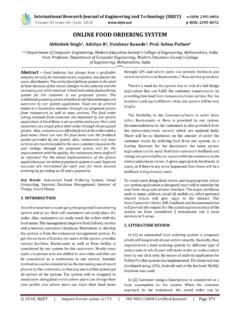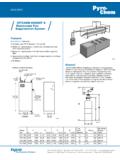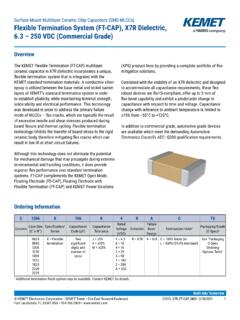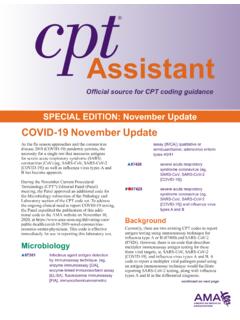Transcription of CMS Manual System
1 CMS Manual System Department of Health & Human Services (DHHS) Pub. 100-07 State Operations Provider Certification Centers for Medicare & Medicaid Services (CMS) Transmittal 47 Date: June 5, 2009 SUBJECT: Revised Appendix A, Interpretive Guidelines for Hospitals I. SUMMARY OF CHANGES: The revised issuance of Appendix A dated October 17, 2008, inadvertently omitted language relating to 42 CFR (c)(1), concerning medical record entries. This revision corrects that omission. NEW/REVISED MATERIAL EFFECTIVE DATE: June 5, 2009 IMPLEMENTATION DATES: June 5, 2009 Disclaimer for Manual changes only: The revision date and transmittal number apply to the red italicized material only.
2 Any other material was previously published and remains unchanged. However, if this revision contains a table of contents, you will receive the new/revised information only, and not the entire table of contents. II. CHANGES IN Manual INSTRUCTIONS: (N/A if Manual not updated.) (R = REVISED, N = NEW, D = DELETED) (Only One Per Row.) R/N/D CHAPTER/SECTION/SUBSECTION/TITLE R Appendix A/ (c)(1) Standard:/Tag 0450 III. FUNDING: No additional funding will be provided by CMS; contractor activities are to be carried out within their FY 2009 operating budgets.
3 IV. ATTACHMENTS: Business Requirements X Manual Instruction Confidential Requirements One-Time Notification Recurring Update Notification _____ A-0450 ( , Issued: 06-05-09, Effective/Implementation: 06-05-09) (c)(1) - All patient medical record entries must be legible, complete, dated, timed, and authenticated in written or electronic form by the person responsible for providing or evaluating the service provided, consistent with hospital policies and procedures.
4 Interpretive Guidelines (c)(1) All entries in the medical record must be legible. Orders, progress notes, nursing notes, or other entries in the medical record that are not legible may be misread or misinterpreted and may lead to medical errors or other adverse patient events. All entries in the medical record must be complete. A medical record is considered complete if it contains sufficient information to identify the patient; support the diagnosis/condition; justify the care, treatment, and services; document the course and results of care, treatment, and services; and promote continuity of care among providers.
5 With these criteria in mind, an individual entry into the medical record must contain sufficient information on the matter that is the subject of the entry to permit the medical record to satisfy the completeness standard. All entries in the medical record must be dated, timed, and authenticated, in written or electronic form, by the person responsible for providing or evaluating the service provided. The time and date of each entry (orders, reports, notes, etc.) must be accurately documented. Timing establishes when an order was given, when an activity happened or when an activity is to take place.
6 Timing and dating entries is necessary for patient safety and quality of care. Timing and dating of entries establishes a baseline for future actions or assessments and establishes a timeline of events. Many patient interventions or assessments are based on time intervals or timelines of various signs, symptoms, or events. (71 FR 68687) The hospital must have a method to establish the identity of the author of each entry. This would include verification of the author of faxed orders/entries or computer entries.
7 The hospital must have a method to require that each author takes a specific action to verify that the entry being authenticated is his/her entry or that he/she is responsible for the entry, and that the entry is accurate. The requirements for dating and timing do not apply to orders or prescriptions that are generated outside of the hospital until they are presented to the hospital at the time of service. Once the hospital begins processing such an order or prescription, it is responsible for ensuring that the implementation of the order or prescription by the hospital is promptly dated, and timed in the patient s medical record.
8 When a practitioner is using a preprinted order set, the ordering practitioner may be in compliance with the requirement at (c)(1) to date, time, and authenticate an order if the practitioner accomplishes the following: Last page: Sign, date, and time the last page of the orders, with the last page also identifying the total number of pages in the order set. Pages with Internal Selections: Sign or initial any other (internal) pages of the order set where selections or changes have been made.
9 O The practitioner should initial/sign the top or bottom of the pertinent page(s);and o The practitioner should also initial each place in the preprinted order set where changes, such as additions, deletions, or strike-outs of components that do not apply, have been made. It is not necessary to initial every preprinted box that is checked to indicate selection of an order option, so long as there are no changes made to the option(s) selected. In the case of a pre-established electronic order set, the same principles would apply, so that the practitioner would date, time and authenticate the final order that resulted from the electronic selection/annotation process, with the exception that pages with internal changes would not need to be initialed or signed if they are part of an integrated single electronic document.
10 Authentication of medical record entries may include written signatures, initials, computer key, or other code. For authentication, in written or electronic form, a method must be established to identify the author. When rubber stamps or electronic authorizations are used for authentication, the hospital must have policies and procedures to ensure that such stamps or authorizations are used only by the individuals whose signature they represent. There shall be no delegation of stamps or authentication codes to another individual.















